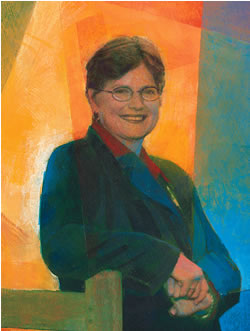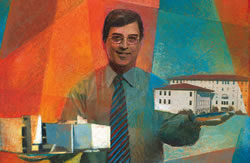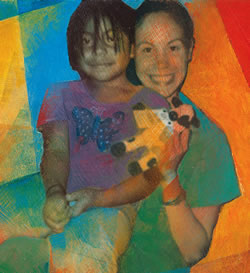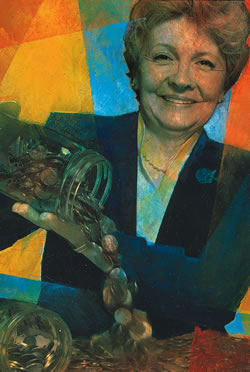



Under Dean Marla Salmon, the nursing school has become a choice destination for students who aspire to become leaders in health care. The school has used pioneering approaches and budgetary discipline to solve complex problems and grow its academic enterprise -- lessons that Emory's other schools now look to as they face similar challenges.


Catching the fire of greatness requires a certain amount of readiness



When the $22 million School of Nursing building was dedicated in 2001, no one was prouder than WHSC Chief Financial Officer Ronnie Jowers, who found a way to pay for it. Emory Hospital purchased the old nursing school building for $8.5 million, the university matched that, and the nursing school raised the rest. The state-of-the-art building was completed $2 million under budget. Savings went into an endowment to pay for utilities and future maintenance and repairs.


Satisfying the demand for nurses


Fuld Fellow Kelly Moynes combined her coursework with service learning at the Family Farmworker Program in Moultrie.


Associate Dean of Business and Finance Susan Eckert helped move the nursing school into the black by changing the mindset about spending.

This fall, for the first time in anyone's memory, the nursing school had a waiting list.

Just the facts Founded
Nell Hodgson Woodruff
School of Nursing

1905 as a training school for nurses at Wesley Memorial Hospital (later renamed Emory University Hospital). Became Emory University School of Nursing in 1944. Renamed in 1967 for Nell Hodgson Woodruff, tireless nursing school advocate and wife of Robert Woodruff.
Faculty/staff
70 faculty (full time, part time, affiliate),
47 staff
Students
362 (increase of 59 since 2002)
Degrees
Research
Funding almost doubled in past four years. Focuses: symptoms and their interactions, cardiovascular disease and quality of life, caregiving and the elderly, cancer in African Americans
Major programs
Kudos

In this issue
From the CEO / LettersHow Nellie got her groove back
Trapping the mutant virus
Doing a 360 in the WLA
Moving forward
Noteworthy
On Point:
Not the same old, same old

By Pam Auchmutey
Marla Salmon will never forget her first faculty meeting as dean of the Nell Hodgson Woodruff School of Nursing. Flanked by her department chairs, Salmon informed the faculty that the school was bleeding red ink and its finances were much worse than she ever imagined. Immediate steps were needed to preserve the school's academic mission and face up to economic reality.
The school would no longer pay 12-month salaries to faculty who taught only during the fall and spring semesters. Faculty contracts were reduced to nine months, with contract options for those who worked in the summer. Essentially, faculty salaries were being cut 25%, a drastic but necessary step to help cure nursing's ailing finances and properly align faculty appointments and salaries with actual responsibilities.
"The money everyone thought was there wasn't," Salmon says. "We threw open the budget so they could see how bad it really was. There were two things that everyone took away from that meeting. One was that it wasn't personal because I didn't know them. The second was that we would act. We were not going to wait."
It was the first of many tough moves that Salmon and other Emory leaders have taken to bring the nursing school back from the brink, indeed to keep it from closing its doors. Since that pivotal meeting four years ago, Salmon and her faculty and staff not only have moved the school's finances into the black but also made it a stronger, more visible partner in the Woodruff Health Sciences Center (WHSC). Classes are filled, research is at record levels, and the school's star is rising.
In the process, Salmon has meshed her own vision of nursing with the groundwork laid by others before her who believed the school's problems, though serious, were surmountable.
Beyond yesterday's aspirations
"Catching the fire of greatness requires a certain amount of readiness," Salmon says. "It also requires a compelling vision, a sense of capacity that's boosted by doing things well, being seen as able to do things well, and doing them better than anyone."
Almost 100 years after its founding, the School of Nursing (SON) is obviously "ready," even thriving in that positive mindset. That wasn't always the case.
Historically, the nursing school evolved from a training school for hospital nurses into a university school offering bachelor's and then master's degrees. At the same time, the university struggled to strike a balance between liberal arts education and professional education, traditionally dominated by the School of Medicine. Before the 1980s, Emory did not conceive of itself as it is known today -- an internationally recognized research institution. "The aspirations of the nursing school were framed by the early aspirations of the university," explains Salmon. "When other nursing schools were grabbing opportunities and running with them, our school was part of an isolated, regional university."
Emory's destiny changed dramatically when Atlanta businessmen George and Robert Woodruff bestowed their historic $105 million gift on the university in 1979. Their generosity provided new scholarships and facilities for students and expanded research by leaps and bounds through new building construction and faculty recruitment.
At the time, the nursing school - then and now the only health sciences school with undergraduate students - prided itself on its teaching and clinical care but had little or no research. Although the nursing school received funds to establish Woodruff scholarships and fellowships for students, its endowment remained small.
Only recently has nursing begun carving out its role in research and discovery, while continuing to produce new nurses, more than half of whom work in Emory's hospitals after they graduate. It was only this year that the School of Nursing received funds to establish Woodruff professorships, used by other schools to recruit stellar research faculty to Emory during the past two decades. And just three years ago, Sandra Dunbar was appointed to the school's first university professorship, the Charles Howard Candler Professor of Cardiovascular Nursing. Salmon points out that these professorships raise the school's profile as a respected resource and partner at the university table.
Catch-22
As the university grew, the nursing school seemed isolated, literally and figuratively. The white, three-story building it occupied on Asbury Circle in the early 1970s had no exterior windows and was connected to Emory University Hospital, its longtime partner. Though the new building was quite an achievement at the time, its fortress-like design (nicknamed "Ada's fort" after its feisty dean, Ada Fort) came to symbolize a sense of inwardness and remoteness from the health sciences center and the university.
That feeling was not lost on Ronnie Jowers, vice president for health affairs and WHSC chief financial officer, whom Salmon regards as the nursing school's "godfather." When Jowers joined Emory in 1987, he saw a nursing school caught in a proverbial catch-22. It was part of an institution poised for tremendous growth in biomedical research but lacked the resources to grow in that direction. It had little faculty research, no doctoral program, and no space for expanding programs and attracting research faculty. To develop a research program, it needed doctoral students and faculty to support it. "It was a vicious cycle," Jowers says.
To compound matters, the school faced serious financial difficulties. Nursing was unlike the schools of medicine and public health, which brought in money through both education and research. The medical school also had clinical income. The nursing school had one income source -- tuition. "With a small endowment and high fixed costs for faculty (approximately 70 full time compared with about 35 now), missing even a couple of students really hurt," Jowers says.
Jowers and others were not ready to give up. Mary Woody, interim dean in 1992, argued the school could not recruit faculty and students and move forward without appropriate space. A new building was key.
That task fell to the new dean, Dyanne Affonso, who came to Emory in 1993 with an impressive record of NIH-funded research. Under her leadership, nursing research expanded and a doctoral program, on the table for several years, was approved. She and Jowers helped develop plans for a new 100,000-square-foot building to rise five stories next to the Rollins School of Public Health, its natural interdisciplinary partner, on Clifton Road. The building would serve as a gateway to Emory's health sciences complex along the Clifton Corridor and provide a state-of-the-art teaching pavilion and clinical skills laboratory.
As plans for its new home took shape, the nursing school's momentum also was building. But the school's future was still on shaky ground when Affonso resigned as dean in 1998.
Adrift without a rudder
By then, the WHSC had undergone its own culture change. Like his predecessor, Michael Johns, the WHSC's new executive vice president for health affairs, deeply respected nurses. He knew that dramatic challenges in the health care system - an aging population, a national nursing shortage, and the need for new approaches to health care - required nurses to be cutting-edge partners in research and patient care. But what he saw at Emory was a nursing school adrift without a rudder.
"There was a lot of faculty unrest at the time," Johns recalls. "The school had a lot of programs in place. Some research efforts were moving just fine; others were struggling. There was ongoing discussion about whether we even needed a nursing school. My sense was that we are a health sciences center, nursing is an integral part of health care, and it's going to be increasingly important. So the issue was how do we find that sense of direction?"
The answer came after a search committee for dean identified Salmon - an expert on nursing workforce issues, health care policy, and public health nursing - as an ideal match for the health sciences and Emory. It was no coincidence that James Curran, dean of the Rollins School of Public Health, led that search. Nursing and public health are natural partners who share the belief that keeping people healthy extends beyond the bedside and into the community and public arenas. Today, Emory is the only US university where the deans of nursing and public health hold reciprocal faculty appointments.
"There are a lot of potential natural ties between public health and nursing," Johns explains. "Many of the issues that nursing research examines have public health implications. We needed to have a dean like Jim in the health sciences chairing the committee because it made a statement about the nursing school's importance and wanting to build bridges between both schools."
Salmon wasn't looking for a job when Emory called. But the nation's former chief nurse (director of nursing in the US Department of Health and Human Services) was intrigued by the possibilities at Emory.
"This university was unapologetic about trying to do good," recalls Salmon, who at the time was associate dean for graduate studies at the University of Pennsylvania School of Nursing. "Because Emory's nursing school had not progressed as rapidly as some other nursing schools, the lines between nursing and other disciplines weren't set in stone. The possibility for expanding our collaborations in teaching and research was an enormous draw and has turned out to be a real asset for us and for the university."
Salmon soon had her hands full as dean. For one thing, the school's finances were a mess. Only 7% of its revenue came from endowment income. And nursing's budget reserve was well under $1 million -- half of what Salmon had expected. "We had to draw down on our reserve for a long time. There had been a decline in enrollment for years."
Strong steps were needed to move the school forward. Salmon and her senior staff knew they not only had to rebuild their finances, but also look closely at their recruitment practices. They scrapped the old budget (which projected twice the enrollment the school actually had) and started over with a deficit budget. "I'm not starting out with a promise that I can't keep," Salmon told her staff.
In her first official budget presentation to Emory's leadership, Salmon proposed a three-year plan for moving the school out of deficit that included a radical catch: a 23% tuition increase that would attract students, not drive them away. Naturally, some observers were skeptical.
"We don't even price ourselves with our peers at fine private schools," she argued. "If we have a public university tuition but want to attract people who are going to fine private schools, what's the message? We're not worth as much as they are?"
Besides raising tuition (which the school now does every other year), Salmon proposed moving forward with a deficit budget and made a commitment to balance the budget by the end of the third year. Instead, the school balanced its budget in two years, and enrollment began to rise. This past spring, student applications were 48% ahead of 1999, and for the first time in anyone's memory, the school had a waiting list for fall.
How they did it
Enrollment has increased for various reasons. The SON beefed up its recruitment efforts (and reduced costs) by combining admissions and student services into one office and hiring its first assistant director of financial aid to help students find creative ways to pay for their education. And coordinators for the school's 13 master's programs are expected to recruit graduate students in addition to their other duties.
External factors have helped jump-start enrollment too. Following 9/11, applications to the nation's schools of nursing rose as people searched for more meaningful careers. The slow economy and subsequent job cuts have prompted others to pursue nursing, where jobs are plentiful because there aren't enough nurses to fill them.
While increasing the number of students and the tuition boost have helped the bottom line, Salmon knew that the SON needed an experienced administrator to oversee the school's financial strategy and help build the school's expertise in research administration. In early 2001, just after the move into the new building, the dean recruited Susan Eckert, a 20-year veteran of the Department of Microbiology and Immunology in the School of Medicine.
Eckert deserves much of the credit for the financial turnaround. "When I got here, we were headed for another deficit year unless we got a handle on spending," she says. "I had to make some very basic changes to certain spending practices to get the school's attention about saving money."
Eckert scrutinized each expense and implemented cost-saving measures, from the simple (such as switching from multiple-line to single-line telephones) to the more complex (such as approaches to using extramural funding sources). "People here thought some changes, like questioning the number of color copies, were just silly, " she recalls. "I did that on purpose, not because saving 70 cents on a color copy was going to make or break us, but to change the mindset of the school about spending money.
"A lot of people here think we're one of the richest universities, so money is no object. Well, it absolutely is. If you spend it now, you won't have it later. When stock prices dropped and the endowment stopped paying as well, the nursing school was in good stead -- we had tightened our spending habits and eliminated most excesses.
"Faculty and staff have been terrific in their cooperation," adds Eckert, who has worked with Salmon on a series of salary equity studies to ensure that faculty salaries are competitive. "They've been an important part of our turnaround because they've kept the best interests of the school at heart. As a result, our organization will sustain itself."
Not for everyone
That's because educating excellent nurses remains the common denominator, as evidenced at Saturday open houses where Salmon personally welcomes prospective students checking out the nursing school. She's clear about who belongs here.
Her spiel: "If you're interested in just doing nursing, you're in the wrong place. If you're committed to improving nursing and the care nurses give and to being haunted your entire career by needs that aren't being met, then you're at the right place. We want students who can change the world."
This means students like the school's new Fuld Fellows, who embody what Salmon calls the "school's mantra of leadership, scholarship, and social responsibility." These second-career students combine their coursework with service-learning opportunities in areas such as migrant health and homelessness to become nurses committed to tackling social issues. That includes fellows like Emile Crosa, an aspiring family nurse midwife with a passion for helping people who lack access to health care. Her interest is rooted in the struggles of a close family member who suffers from schizophrenia and finds it difficult to get help with her special needs within the confines of the current health care system. Crosa is enrolled in the Emory Nursing Segue Program, funded with $5 million from the Helene Fuld Health Trust -- the largest single gift in the school's history. The program, in which students earn both bachelor's and master's degrees, is the result of a concerted effort led by Salmon to increase scholarships and promote service learning, both high priorities at the SON.
Conversely, the School of Nursing serves as a model for what to do when scholarship funding disappears. For years, the school relied on the university's courtesy scholarship benefit to fill its graduate classes. The benefit enabled nurses at Emory University and Emory Crawford Long hospitals to complete their master's degrees tuition-free and continue working.
That changed with the recent transition to One Emory Healthcare, which consolidated hospital, Emory Clinic, and Wesley Woods employees and their benefits under one umbrella. As a result, employees can no longer use the courtesy scholarship to further their own education (though their dependents are still eligible). Instead, employees may use tuition reimbursement, in which Emory Healthcare repays 80% of their tuition after employees successfully complete courses (in and outside of Emory) related to their jobs. In 2002-2003, 123 nurses used the courtesy scholarship benefit, for which Emory Healthcare paid $1.5 million in tuition -- income the nursing school could not afford to lose. Concerned that few hospital nurses could afford to pay tuition costs up front under the reimbursement option, the nursing school had to find a way to replace that income.
"The courtesy scholarship had made it easy to fill those classes because the benefit was so generous," says Eckert, the nursing school's associate dean for business and finance. "Fortunately, we knew that the benefit was going to change, so we started concentrating on master's recruitment. Previously, the role of the master's coordinator in recruitment was informal. We made it a significant role with targets for each of the 13 master's programs."
That strategy has paid off. This fall, the nursing school enrolled 79 master's-degree students (its target goal was 75), not counting the last courtesy scholarship students, who must enroll by January 1, 2004, to be eligible. Thus the program has become a desired destination for students rather than just a feeder for Emory Hospitals nurses.
"The faculty had to become involved in graduate recruitment because there's only so much the admissions staff can do," Eckert says. "The admissions staff has to concentrate on filling the bachelor's program (94 students this year, compared with 78 last year) and the student advising that new undergraduates require."
World-changing fare
Even with its growing pains - both acute and chronic - the school's journey into the 21st century has been worthwhile. Besides benefiting from the tough measures implemented by Salmon and her team, the school has received an infusion of federal and other monies to support new educational, research, and service initiatives. As a result, students at the school now feast from a rich banquet of world-changing fare that's come about, in large part, as a result of Salmon's collaborative vision and networking.
Not long after she arrived, Salmon established the Lillian Carter Center for International Nursing. Named for President Jimmy Carter's late mother (a nurse and Peace Corps volunteer), the center is tackling the nursing shortage and other workforce issues on a global scale. It has established academic exchanges for students and faculty in South Korea and Canada; expanded collaborations with public health partners like the CDC and The Carter Center, including the Ethiopia Public Health Training Initiative led by Joyce Murray; and provided students opportunities to learn firsthand about health care in Cuba and migrant health in South Georgia.
To enhance the curriculum, nursing school faculty have aggressively pursued new federal training dollars to support its new doctoral program as well as graduate programs in public health nursing leadership, nursing administration leadership, women's health, and family nurse-midwifery. Just recently, Laura Kimball, coordinator for the new emergency nurse practitioner program, and Arthur Kellermann, chair of emergency medicine in the School of Medicine, received a grant to boost training for nurse practitioners in emergency, acute, and trauma care.
The most dramatic area of growth at the SON is nursing research. Key to that boom is the Center for Research on Symptoms, Symptom Interactions, and Health Outcomes, which has helped attract unprecedented research dollars. Spearheaded by Director Kathy Parker, it's one of nine exploratory centers in the country that provide infrastructure and start-up funds for nursing research and encourages collaboration between nurses and researchers from the School of Medicine in such areas as cardiac care, oncology, aging, and women's health. Seed funding for pilot studies has led to major investigations, such as the five-year, $2 million renewal from NIH for Parker's study of the effects of hemodialysis on the sleep/wake cycle of kidney patients. Faculty member Linda Alley (also a clinician/researcher with the CDC) used her preliminary findings to secure a four-year, $1.4 million NIH grant to study effects of pain and opioid use on cancer patients.
Overall, the school has seen a 250% increase in the number of faculty-generated research applications since 1999. Emory is first among US private nursing schools in the number of doctoral students with NIH funding. In FY03, the school expects to receive approximately $4.2 million in extramural funding compared with $1.2 million in FY99. That's small potatoes perhaps when compared with the schools of medicine or public health. But it's definitely enough to catapult the School of Nursing in the relatively new field of nursing research from 39th to 20th place in NIH funding among 683 schools of nursing.
Important to this success is holding faculty more accountable for obtaining research funding and giving them the skills and opportunities to pursue their areas of studies. After Salmon arrived, she awarded postdoctoral fellowships to three junior faculty. Today, all three have federal RO1 grants, the gold standard of research funding. "That happened because of their own abilities, but Marla paved the way," says Eckert, "by giving them the necessary release time from teaching, as well as salary support and encouragement."
Shoring up shortages
An ongoing challenge for the School of Nursing is filling vacancies when valued faculty members leave. Such losses are felt keenly by the nation's nursing schools, which are experiencing faculty shortages and decline in new enrollments even as the need for nurses continues to grow. The American Association of Colleges of Nursing cites budget constraints, an aging faculty, and increasing job competition from clinical sites as contributing to this emerging crisis. Last year, the nation's nursing schools turned away more than 5,000 qualified students due to insufficient numbers of faculty and other resources. The Department of Health and Human Services expects the current shortage of nurses to double to 12% by 2010.
Rather than wait for someone else to fix the problem, the SON launched a teaching institute this past summer, aimed at putting more faculty in Georgia's nursing schools. Led by Helen O'Shea, the fast-track program targets nurses with master's degrees who have done little or no teaching in an academic setting. When the first 10 students receive their certificates in December, they will be armed with theoretical and practical teaching knowledge and will be prepared to teach at any collegiate nursing school in Georgia, including Emory. Five of the students have joined Emory's nursing faculty within the past year.
What it all boils down to is much more than helping shore up a nationwide shortage of nurses and faculty. It's educating nurses who can thrive anywhere as leaders in patient care and research and who believe in what Salmon calls "a social contract to care."
"Nursing sits at the interface between human beings and illness, poor health, and systems of care," she explains. "Our concern for people extends beyond our jobs and what happens to them beyond the individual exchange or episode. That advocacy is fundamentally important in a health care system driven more by the bottom line than the needs of people."
Improving practice
Salmon's vision goes far beyond finances and supply-and-demand issues. There's plenty of room for improving nursing practice as well. Georgia, for example, is the only state in the nation that does not allow nurse practitioners to write common prescriptions. That means nurses spend a lot of time running from patients to doctors to get physicians to write them.
Enhancing the role of nursing - as does St. Joseph's Hospital, a magnet hospital for nurses who place a high value on nursing autonomy - also would enhance health care delivery. "There are several challenges for nursing right now that are common to all health systems, and some are managing better than others," Salmon says. "One relates to the recognition of nurses and their role as colleagues. There are varying degrees of this in Georgia. St. Joseph's is a wonderful example of a health system committed to improving the work context for nurses and patients in a way where everyone comes out ahead, including doctors."
Toward that end, Salmon and nursing faculty are exploring the feasibility of offering a clinically focused doctorate of nursing practice (DNP). There is a growing national trend to educate nurses as senior clinicians who can develop, manage, and improve patient care. The DNP would complement the nursing school's current doctoral program in scientific research. Kathy Parker, one of the school's thought leaders and a Woodruff Leadership Academy fellow, sees great potential for the nursing school's programs, including the DNP. "Those who complete the DNP program would be prepared to take a leading role in providing and coordinating health care for patients, families, and communities," she says, "and would develop and implement new models of health care delivery."
"It's not that we want to ship our nurses all over the world," Salmon explains. "The world has changed from a perspective that goes beyond working a 7-to-3:30 shift and going home. Our graduates learn to interface with the problems of the world here at Emory, at Grady, in community school systems, in rural clinics, and much more."
Poster child for change
That philosophy has not gone unnoticed. Salmon has raised the profile of the nursing school dramatically. It has become Emory's poster child for responsible management and a more visible partner in the health sciences, the university, and the nation.
Still the nursing school faces a tough road ahead. Endowments, scholarships, and research funding must continue to grow. Faculty recruitment is a priority. The school must continue to seek more creative ways to support Emory's own clinical enterprise. And, like the rest of the university, the School of Nursing must plan and execute an ambitious capital campaign.
Salmon is confident about the future. "We are able to go toe-to-toe with anyone at the university," she says. "And it's within our grasp to be the best private school of nursing in the world."
Pam Auchmutey is editor of Emory Nursing Magazine.
Copyright © Emory University, 2003. All Rights Reserved.
Send comments to the Editors.
Web version by Jaime Henriquez.